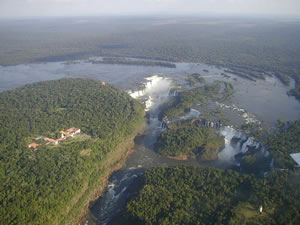The Iguazu Falls in South America are made up of 275 individual waterfalls.
No other falls of comparable size are divided into so many different channels.
The Iguazu Falls are located on the border between Brazil and Argentina.
Each individual waterfall is separated from the next by rocky islands covered in trees.
 The dissection is thought to be brought about by the geology of the plateau, which is formed of solidified lava and tough volcanic rocks, such as basalt.
The dissection is thought to be brought about by the geology of the plateau, which is formed of solidified lava and tough volcanic rocks, such as basalt.
These rocks are not easily eroded; thus, they force water around islands and into channels.
The rise and fall of the Iguazu River's waters depend almost entirely on the seasonal rains falling into its drainage basin.
During the height of the rainy season, from November to March, the river swells to a tremendous flood. At this time, up to 12,768,750 liters (2,812,500 gallons) of water flow over the Iguazu Falls every second.
During the dry season between April and October, the water cascading over the Iguazu Falls decreases dramatically as the river dwindles to a fraction of its maximum size.
The waters of the Iguazu River plunge into a narrow gorge known as the Garganta del Diablo, the "Devil's throat", then wind their way to join the Paraná River, which is around 22km (l4mi) to the south.
After the Amazon and the Orinoco, this is South America's third greatest river. It rises far to the north and flows out into the South Atlantic Ocean via the Rio de la Plata.
Life Around the Falls
The Iguazu Falls are surrounded by an abundant variety of tropical and subtropical plants and animals.
A number of different trees, including the cedar, thrive on the rocky islands that divide the river water. These islands are also home to trumpet vines.
Aquatic herbs, known as riverweeds, thrive on the ledges of the falls. These plants look like water lichens or mosses but are flowering plants. They grow only in running water, some in the midst of the waterfall's spray, others hidden under a ledge.
These plants, which rarely exceed 10cm (4in) in height, have suckers that they use to attach themselves to the rock.
When the water level falls in the dry season, they flower and immediately release pollen, which fertilizes the ovaries of adjacent plants.
A few days later, fruits ripen. They drop on to a nearby rock, where they immediately attach themselves.
When the water level rises again, the seeds germinate and produce new plants.
Birds, including tinamous and parrots, live in the trees.
Swifts nest in the craggy outcrops of the falls, swooping low over the river to feed on the large swarms of insects.
Ocelots, jaguars, tapirs, deer and peccaries roam the forest.